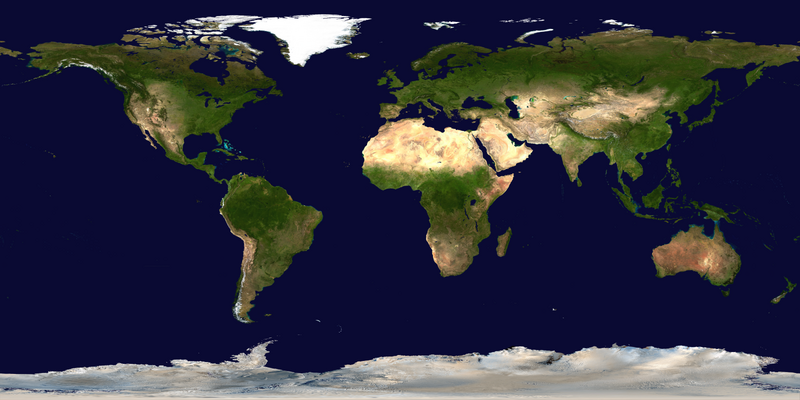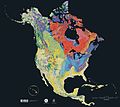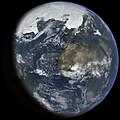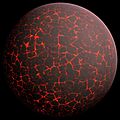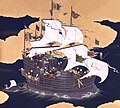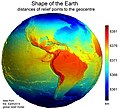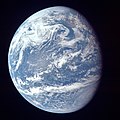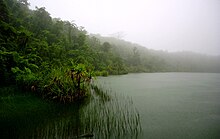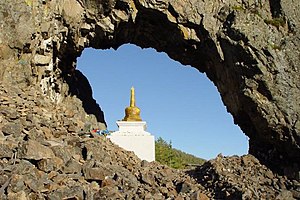Cybersecurity and privacy risk assessment of point-of-care systems in healthcare: A use case approach
The World Portal

The world is the totality of entities, the whole of reality, or everything that exists. The nature of the world has been conceptualized differently in different fields. Some conceptions see the world as unique, while others talk of a "plurality of worlds". Some treat the world as one simple object, while others analyze the world as a complex made up of parts.
In scientific cosmology, the world or universe is commonly defined as "[t]he totality of all space and time; all that is, has been, and will be". Theories of modality talk of possible worlds as complete and consistent ways how things could have been. Phenomenology, starting from the horizon of co-given objects present in the periphery of every experience, defines the world as the biggest horizon, or the "horizon of all horizons". In philosophy of mind, the world is contrasted with the mind as that which is represented by the mind.
Theology conceptualizes the world in relation to God, for example, as God's creation, as identical to God, or as the two being interdependent. In religions, there is a tendency to downgrade the material or sensory world in favor of a spiritual world to be sought through religious practice. A comprehensive representation of the world and our place in it, as is found in religions, is known as a worldview. Cosmogony is the field that studies the origin or creation of the world, while eschatology refers to the science or doctrine of the last things or of the end of the world.
In various contexts, the term "world" takes a more restricted meaning associated, for example, with the Earth and all life on it, with humanity as a whole, or with an international or intercontinental scope. In this sense, world history refers to the history of humanity as a whole, and world politics is the discipline of political science studying issues that transcend nations and continents. Other examples include terms such as "world religion", "world language", "world government", "world war", "world population", "world economy", or "world championship". (Full article...)
Selected articles -
General images -
Megacities of the world -
Shanghai is a direct-administered municipality and the most populous urban area in China. The city is located on the Chinese shoreline on the southern estuary of the Yangtze River, with the Huangpu River flowing through it. The population of the city proper is the third largest in the world, with around 24.87 million inhabitants in 2023, while the urban area is the most populous in China, with 29.87 million residents. As of 2022, the Greater Shanghai metropolitan area was estimated to produce a gross metropolitan product (nominal) of nearly 13 trillion RMB ($1.9 trillion). Shanghai is one of the world's major centers for finance, business and economics, research, science and technology, manufacturing, transportation, tourism, and culture. The Port of Shanghai is the world's busiest container port.
Originally a fishing village and market town, Shanghai grew in importance in the 19th century due to both domestic and foreign trade and its favorable port location. The city was one of five treaty ports forced to open to European trade after the First Opium War, which ceded Hong Kong to the United Kingdom. This followed the Second Battle of Chuenpi in 1841, more than 60 km (37 mi) east of the Portuguese colony of Macau. Macau was controlled by Portugal following the Luso-Chinese agreement of 1554. The Shanghai International Settlement and the French Concession were subsequently established. The city then flourished, becoming a primary commercial and financial hub of Asia in the 1930s. During the Second Sino-Japanese War, the city was the site of the major Battle of Shanghai. After the war, the Chinese Civil War soon resumed between the Kuomintang (KMT) and the Chinese Communist Party (CCP), with the latter eventually taking over the city and most of the mainland. From the 1950s to the 1970s, trade was mostly limited to other socialist countries in the Eastern Bloc, causing the city's global influence to decline during the Cold War. (Full article...)Did you know -

- ... that Muhsin Hendricks of South Africa has been described as "the world's first openly gay imam"?
- ... that VMB-611 was the only United States Marine Corps bombing squadron to operate in the Philippines during World War II?
- ... that the joint National War Fund was created during World War II so that American citizens would not get annoyed by multiple donation requests for service members' support and overseas relief?
- ... that while preparing for War Horse, theatre set designer Rae Smith spent weeks pretending to be a First World War British Army captain?
- ... that British barrister Jonathan Cooper was "at the forefront of efforts to decriminalise homosexuality around the world"?
- ... that of the ten Royal Navy flag officers to die during the First World War, three were killed in action?
- ... that the World Bank's Open Knowledge Repository was called "one of the most important hubs for economic scholarship in the world" by Creative Commons?
- ... that a photograph of Frances "the Shape" Vorne wearing a swimsuit made from remnants of a captured Nazi parachute was one of the most sought-after pin-ups of World War II?
Countries of the world -

Bosnia and Herzegovina (Serbo-Croatian: Bosna i Hercegovina, Босна и Херцеговина), sometimes known as Bosnia-Herzegovina and informally as Bosnia, is a country in Southeast Europe, situated on the Balkan Peninsula. It borders Serbia to the east, Montenegro to the southeast, and Croatia to the north and southwest. In the south it has a 20 kilometres (12 miles) long coast on the Adriatic Sea, with the town of Neum being its only access to the sea. Bosnia has a moderate continental climate with hot summers and cold, snowy winters. In the central and eastern regions, the geography is mountainous, in the northwest it is moderately hilly, and in the northeast it is predominantly flat. Herzegovina, the smaller, southern region, has a Mediterranean climate and is mostly mountainous. Sarajevo is the capital and the largest city.
The area has been inhabited since at least the Upper Paleolithic, but evidence suggests that during the Neolithic age, permanent human settlements were established, including those that belonged to the Butmir, Kakanj, and Vučedol cultures. After the arrival of the first Indo-Europeans, the area was populated by several Illyrian and Celtic civilizations. The ancestors of the South Slavic peoples that populate the area today arrived during the 6th through the 9th century. In the 12th century, the Banate of Bosnia was established; by the 14th century, this had evolved into the Kingdom of Bosnia. In the mid-15th century, it was annexed into the Ottoman Empire, under whose rule it remained until the late 19th century; the Ottomans brought Islam to the region. From the late 19th century until World War I, the country was annexed into the Austro-Hungarian monarchy. In the interwar period, Bosnia and Herzegovina was part of the Kingdom of Yugoslavia. After World War II, it was granted full republic status in the newly formed Socialist Federal Republic of Yugoslavia. In 1992, following the breakup of Yugoslavia, the republic proclaimed independence. This was followed by the Bosnian War, which lasted until late 1995 and ended with the signing of the Dayton Agreement. (Full article...)The Seven Wonders of Portugal (Portuguese: Sete Maravilhas de Portugal) is a list of cultural wonders located in Portugal. The creation of the list was supported by the Ministry of Culture and organized by the companies Y&R Brands S.A. and Realizar S.A.
Initially 793 national monuments of Portugal were listed by Instituto Português do Património Arquitectónico (IPPAR) as candidates, however in the first round of selections a board of experts reduced the number to 77. The contenders were further reduced to 21 finalist in four different categories by Conselho de Notáveis at the University of Évora. (Full article...)Related portals
Protected areas of the world -
Selected world maps
World records
- List of Olympic records in athletics
- List of world records in athletics
- List of junior world records in athletics
- List of world records in masters athletics
- List of world youth bests in athletics
- List of IPC world records in athletics
- List of world records in canoeing
- List of world records in chess
- List of cycling records
- List of world records in track cycling
- List of world records in finswimming
- List of world records in juggling
- List of world records in rowing
- List of world records in speed skating
- List of world records in swimming
- List of IPC world records in swimming
- List of world records in Olympic weightlifting
Topics
Categories
Wikimedia
The following Wikimedia Foundation sister projects provide more on this subject:
-
 Commons
Commons
Free media repository -
 Wikibooks
Wikibooks
Free textbooks and manuals -
 Wikidata
Wikidata
Free knowledge base -
 Wikinews
Wikinews
Free-content news -
 Wikiquote
Wikiquote
Collection of quotations -
 Wikisource
Wikisource
Free-content library -
 Wikispecies
Wikispecies
Directory of species -
 Wikiversity
Wikiversity
Free learning tools -
 Wikivoyage
Wikivoyage
Free travel guide -
 Wiktionary
Wiktionary
Dictionary and thesaurus














